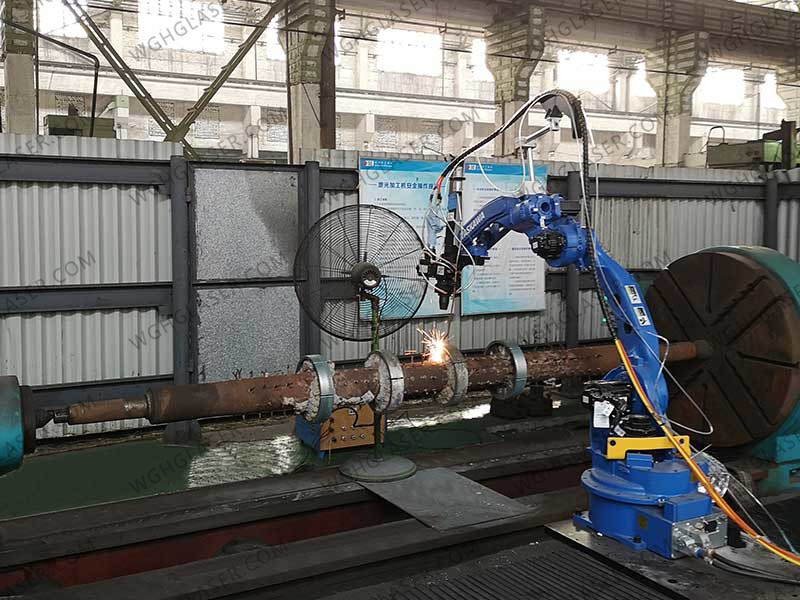Principle of laser cladding process equipment
Laser cladding, as the name suggests, is a new type of surface modification material technology. According to the method of adding cladding materials on the surface of the substrate, and then using all the machinery and equipment such as higher energy relative density to fuse, the production is completed. Technical craftsmanship.
Cladding process:
Laser cladding can be divided into two types according to the method of providing cladding materials, namely, preset laser cladding and synchronous laser cladding.
The preset laser cladding is to place the cladding material on the cladding position on the surface of the substrate in advance, and then use a laser irradiance scanner to melt, and the cladding material is added in the form of powder, wire, and plate. It is more common in powder form.
Synchronous laser cladding is to send the cladding material to the laser, so that the feeding and cladding are performed separately. The key to the cladding material is also to feed it in powder form. Of course, some people choose cables or boards to carry out synchronous feeding.
The key production process of preset laser cladding: first, the substrate cladding surface preparation treatment, and then preset the cladding material, then heat, laser fusion, and finally heat treatment process.
The key production process of synchronous laser cladding: first, the surface of the substrate cladding is prepared, then the material is fed for laser melting, and finally the heat treatment process is performed.
Laser principle:
The laser cladding mechanical equipment is composed of laser, refrigeration generator set, powder feeding organization, production and processing console, etc. The laser uses a solid-state laser and a common CO2 laser. Among them, CO2 lasers are the most widely used lasers with the largest number of types. They are used in the automobile industry, steel industry, shipbuilding industry, airlines and aerospace industry, motor industry production, mechanical engineering, steel industry, laser cutting processing of metal materials, etc. Widely used in the industry. It accounts for about 40% of the world’s total industrial production laser sales, and even 70% in North America. The laser has the following characteristics:
1. High output power. CO2 laser is one of the lasers with the highest level of power at this stage, and its large continuous power reaches several hundred thousand watts.
2. High efficiency. The photoelectric conversion rate is over 30%, which is much higher than other production and processing lasers.
3. High light quality. The use method is good, the use rate in related industries is high, and the line width is relatively stable in work use.
Cladding process:
Laser cladding can be divided into two types according to the method of providing cladding materials, namely, preset laser cladding and synchronous laser cladding.
The preset laser cladding is to place the cladding material on the cladding position on the surface of the substrate in advance, and then use a laser irradiance scanner to melt, and the cladding material is added in the form of powder, wire, and plate. It is more common in powder form.
Synchronous laser cladding is to send the cladding material to the laser, so that the feeding and cladding are performed separately. The key to the cladding material is also to feed it in powder form. Of course, some people choose cables or boards to carry out synchronous feeding.
The key production process of preset laser cladding: first, the substrate cladding surface preparation treatment, and then preset the cladding material, then heat, laser fusion, and finally heat treatment process.
The key production process of synchronous laser cladding: first, the surface of the substrate cladding is prepared, then the material is fed for laser melting, and finally the heat treatment process is performed.

Laser principle:
The laser cladding mechanical equipment is composed of laser, refrigeration generator set, powder feeding organization, production and processing console, etc. The laser uses a solid-state laser and a common CO2 laser. Among them, CO2 lasers are the most widely used lasers with the largest number of types. They are used in the automobile industry, steel industry, shipbuilding industry, airlines and aerospace industry, motor industry production, mechanical engineering, steel industry, laser cutting processing of metal materials, etc. Widely used in the industry. It accounts for about 40% of the world’s total industrial production laser sales, and even 70% in North America. The laser has the following characteristics:
1. High output power. CO2 laser is one of the lasers with the highest level of power at this stage, and its large continuous power reaches several hundred thousand watts.
2. High efficiency. The photoelectric conversion rate is over 30%, which is much higher than other production and processing lasers.
3. High light quality. The use method is good, the use rate in related industries is high, and the line width is relatively stable in work use.